2007 Fire Season Forestry education Saving Forests The 2008 Fire Season
by admin
Clearcuts Don’t Burn
By Derek Weidensee
I’d like to share with readers of W.I.S.E. and SOS Forests several photographs I’ve taken of seven different Montana wildfire burns — of a phenomenon I call “clearcuts don’t burn”!
Unburned area on the right is a 25-year-old regenerated clearcut. Photo by Derek Weidensee. Click for larger image
In fairness, I should say clearcuts seldom burn. The “green islands” in a sea of burned old forest are often “regenerated” clearcuts.
The Rat Creek Fire (2007) Burn west of Wisdom, MT, in 2009. Photo by Derek Weidensee. Click for larger image
This is a hobby of mine. I’ve spent my last four summer vacations going to Montana to study and photograph this phenomenon. I think it’s the best kept secret of forestry.
A 30-year-old regenerated clearcut surrounded by burned forest. Photo by Derek Weidensee. Click for larger image
This phenomenon is especially relevant in light of the massive mountain pine beetle epidemic in the West and the debate over proposals to salvage log in the name of reducing fire hazards. For the last twenty years the USFS has cited “changing public values” as one reason to reduce timber harvest. Well, public values are changing back again. From Colorado to Montana, the public is demanding more timber harvest to alleviate the fire risk. In the town of Breckenridge Colorado, which is a very pro-environmentalist community, the USFS is proposing to salvage clearcut 5,000 acres of MPB killed timber around the city limits. The watershed that provides 80% of Helena Montana’s drinking water is heavily infested with MPB. A proposal is underway that would salvage log 30% of it in “strategic” patterns to mitigate fire hazard.
Williams Fork, CO, 35 miles north of Dillon. A mosaic with a 25-year-old regenerated clearcut in foreground, a 1-year-old beetle salvage clearcut in background, and a beetle-killed forest to right. Photo by Derek Weidensee. Click for larger image
In this era of timber litigation and the USFS reliance on “best available science”, it seems that if it hasn’t been published, then it has never happened. I’m not a forest research professional, but surveying has trained me to observe the land. My goal in submitting this to W.I.S.E. for publication, is to stimulate the research community to actively research this phenomenon and publish about it.
SW of Bozeman, MT, on the Purdy Fire (2006) Burn in 2009. The 10-year-old regenerated clearcut in the foreground did not burn. The Bozeman watershed, producing 90% of their drinking water, is about 5 miles E of here. It’s very possible that this clearcut and others kept the Purdy Fire from spreading to Bozeman watershed. The city of Bozeman has stated that a high intensity fire in their watershed would overwhelm the treatment plant with sediment and ash. It would necessitate the public drinking bottled water for 6 months. Photo by Derek Weidensee. Click for larger image
I hope these photo’s help answer the question: does logging reduce the severity of forest fires? The next time you hear an environmentalist claim that logging not only doesn’t prevent fires but makes them worse, refer them to these photos.
I first discovered this phenomenon when Steven Arno made an obscure mention of it in one of his books. Then I was scanning an area about ten miles south of West Yellowstone Montana with Google Earth and noticed a straight line dividing a green area on the west and a gray area on the east. We all know that nature abhors a straight line so it caught my attention. It dawned on me that it was the Yellowstone Park boundary. The green area on the west was an unburned regenerated lodgepole clearcut that had survived the 1988 wildfire, the gray area was burned mature forest inside the park.
Looking over the clearcut to the “wall” of dead forest in Yellowstone on the park boundary. The burn extends thirty miles east to Old Faithful. Photo by Derek Weidensee. Click for larger image
Looking north along the boundary with Yellowstone NP on the right, Targhee NF on the left. Managed lands with clearcuts did not burn; unmanaged lands with accumulated fuels burned severely. 2009 photo by Google Earth. Click for larger image
That was my epiphany! I spent about five years of my logging career in the early 80’s salvage clearcutting pine beetle killed lodgepole around West Yellowstone. In 1988 a million acres of untreated areas inside the Park burned.
The USFS did a study authored by Philip N. Omi and Kostas D. Kalabokidis in 1991 after the Yellowstone fire:
Omi, Philip N., and Kostas D. Kalabokidis. 1991. Fire Damage on Extensively vs. Intensively Managed Forest Stands Within the North Fork Fire, 1988. Northwest Science, Vol. 65. No. 4, 1991
Abstract
The Greater Yellowstone fires of 1988 provide an opportunity to study important distinctions between lands managed for preservation versus multiple uses. We surveyed fuel loadings, fire severity, and fire damage in extensively managed mature forests and intensively managed clearcut reproduction areas. Unburned mature forests support higher fuel loadings in the large and small woody fuel size classes. Fifty percent of the 50 fire severity estimates in mature forest plots were given the highest ratings possible for flame lengths and ground char. Fire damage rated highest on 89% of the 55 mature forest plots based primarily on crown scorch indicators. By contrast, highest fire damage ratings were associated with only 20% of the 45 regeneration sites surveyed. Fire severity and damage were moderated in intensively managed areas. Intensively managed forest areas improve fire management options in the Greater Yellowstone Area.
I walked the same clearcuts the authors refer to. The summary of the study states, “Fire severity was greatest on mature forest sites on national park lands, as opposed to areas with saplings in regenerated clearcuts on national forest lands” and “90% of mature forests suffered severe fire damage while only 20% of regenerated clearcuts did.”
Why haven’t we seen more published research into this phenomenon? Before environmental lawsuits, most research was only read by others in the forestry profession. I think Phil Omi said it best:
Forest researchers never paid much attention to it because it was already common knowledge among forestry professionals…no one wanted to publish research on something that was already common knowledge.
Theresa Jain et al. (2007) touched on the phenomenon in their 2006 study:
Jain, Theresa B., and Russell T. Graham. 2007. TThe Relation Between Tree Burn Severity and Forest Structure in the Rocky Mountains. USDA Forest Service Gen. Tech. Rep. PSW-GTR-203.
The authors found a strong association between low canopy base height of the regenerated clearcuts and low burn severity. They also found that:
In both of these fire groups, thinned stands, plantations, and other stands exhibiting management typified this outcome. The forest floor conditions exhibited in these fire groups could be associated with stand initiation structural stages which frequently contain moist and robust layers of ground-level vegetation. Because these stands were managed, the surface fuel matrix was modified through slash disposal and site preparation activities resulting in a discontinuous fuel bed. Crown fires would burn around these areas and most often there was evidence that firebrands landed in these stands. However, surface fuel conditions prevented sufficient fire from developing that could burn or scorch the tree crowns. These results indicate that high stand densities and low canopy base heights do not necessarily lead to a crown fire or black stems.
The Beaverhead Deerlodge NF made an assessment of the Basin Creek Hazardous Fuels Reduction Project south of Butte, MT. The authors noted:
Local experience has shown that lodgepole pine regeneration stands will not burn. …
Clearcuts remained unburned even when active crown fire burned the entire area surrounding them. …
[E]mpirical evidence on the Wisdom Ranger District, under severe fire and weather conditions during the Mussigbrod Complex Fires in 2000 and the Sheep Creek Fire in 2002, suggests that clearcuts remained unburned even when active crown fire burned the entire area surrounding them (Hutton 2001). Even clearcuts as old as 35 years and as tall as 30 feet would not burn. … [C]learcuts often acted as fire breaks during that extreme fire season.
I’ve read dozens of USFS EIS’s and EA’s, and frankly the litigation-driven reliance on published “best available science” means the public doesn’t have a clue what the EIS authors are talking about. Nothing makes the public’s eyes glaze over faster than fuel models, fire groups, fire regime condition class, canopy bulk density, etc. etc. Local experience carries a lot of weight with the local public. And pictures are worth more to the public than the thousands of words in the fires and fuels section of an EIS. It’s unfortunate local experience doesn’t seem to carry much weight with a judge.
Changing public values about logging probably means you don’t have to sell these MPB salvage timber sales to most of the public. It’s intuitive (for most of the public) to realize that piles of deadfall are a big fire hazard. It’s amazing to me how abstract environmental idealism goes out the window when private and public property values are threatened by a beetle epidemic or wildfire.
Some of the public are swayed by environmentalist claims that salvage logging not only doesn’t help the fire hazard but makes it worse. You can’t assume these people will defer to professional judgment. I don’t think you’ll ever convince the radical enviros, but the vast majority of people who identify themselves as environmentalists are of the pragmatic moderate kind. Pine beetle and wildfire are stripping support away from the radicals. To convince those people, I wish there was a website or central database they could be referred to that features photo proof of the efficacy of fuels treatments backed up by published research of case studies.
Case studies aren’t hard to find. It’s easy to overlay a burn severity map over a past treatment map. It’s a very effective visual. It’s how I found most of the clearcuts that didn’t burn. I would like to share just a couple possible cases I’ve found.
I’ve taken two trips to the 30,000 acre Brush Creek Burn that burned in 2007 just west of Whitefish, MT. Some of the photos above were taken withing that Burn. Here’s a quote from the USFS environmental assessment for the Sheppard Creek Post Fire Project which proposes to salvage the Brush Creek Fire.
On areas with past timber harvesting (clearcuts), 75% suffered moderate, low or no fire damage while 25% suffered severe damage. On areas without timber harvesting (old forest) only 5% suffered low damage while 75% suffered high burn severity.
It is also interesting to note that 50% of the Brush Creek Burn had been clearcut in the 1980s — salvage sales of beetle-killed lodgepole pine. The reason the old forest burned was because of heavy surface fuels due to that beetle epidemic 20 years ago. Forty percent of the forest within the burn perimeter is still green, and 90% of that is regenerated clearcuts from the 1980s. The USFS found water clarity after the fire to be “surprisingly clear”.
I also visited the Chippy Creek Burn which burned in 2008. Only 15% of the 26,000 acre Rock Creek watershed had been logged. They estimate that in the first year, “wildfire induced erosion” will amount to 55,000 tons (that’s 5,000 dump truck loads), while “road induced erosion” amounts to 58 tons. That’s 1000 times more erosion due to the fire than to the roads! Sediment doesn’t seem to be news if a wildfire caused it.
Another case is the Purdy Fire (2006) five miles southwest of the watershed that supplies 90% of Bozeman, MT, drinking water. The prevailing winds were from the southwest. The fire was stopped on the east side by a line of regenerated clearcuts along a ridge on heavily managed former Plum Creek “checkerboard” lands. I can’t speculate that the fire would have reached the watershed if those lands weren’t managed, but it does highlight the hazard to watersheds. A study by the city found they would be drinking bottled water for six months if their watershed burns.
Clearcuts don’t stop a fire, but that’s where they’re eventually stopped. One of my relatives is a USFS type II fire incident commander. I asked him about the clearcuts don’t burn phenomenon and he heartily agreed. He stated that when he’s flying over a fire, coming up with a tactical strategy to contain it, he looks for regenerated clearcuts and old burns to tie his fire lines into and give his firefighters a safety zone to retreat too. Perhaps a good research paper would be to poll these commanders, if the USFS would allow them to express their opinions on matters of public policy.
I won’t touch much on why regenerated clearcuts don’t burn. I think Graham and Jain 2007 (above) covered that subject very well. I would like to share a couple personal observations on why they occasionally do burn. Most of the clearcuts that burned on the Brush Creek Fire were less than 10 years old. They were basically grass fires that overwhelmed the saplings. I don’t think they become effective fire breaks for 20 years until the canopy closes. But the, we know that the fire hazard for a MPB epidemic doesn’t become extreme for 20 years until the deadfall piles up. I’ve never seen a 30-year-old Montana clearcut burn.
Environmentalists have recently been trumpeting research done in Colorado that found salvage logging had no detectable effects on fire severity. It’s interesting to note however, that the researchers made their determination based on a fire burning across a 3-year-old clearcut.
Slope is another important factor. I’ve seen several clearcuts burn on slopes greater than 30%. Due to terrain difficulties, it’s fortunate that a lot of the past clearcuts in the fires cited above were done on ridges or gentle uplands, exactly where firefighters choose to make a stand.
Species is another variable. Spruce-fir seems to burn no matter what age. Most of the fires pictured above were regenerated predominately with lodgepole pine and some larch.
Pre-commercial thinning can have uncertain effects. Slash left in the stand can be very flammable. However, the slash can be rotten enough to kick apart in ten years. Many of the older unburned clearcuts pictured above were thinned 20 years ago.
It’s my hope that the MPB infestations and resulting proposals to salvage log to reduce fire hazard will spur more research into the clearcuts don’t burn phenomenon. Any claim by one side that “they just want to log it all” are as ridiculous as the other side claiming “it’ll all burn”. I do agree with the Colorado researchers who suggest that most of the MPB infested areas won’t burn soon. Law of averages is against it. I know of many beetle-killed areas from past infestations that haven’t burn.
When it comes to salvage logging near the WUI and in areas the public doesn’t want to see burn, keep in mind that while it may be very unlikely your home will burn, you still have to buy insurance. And the premiums you pay are predicated on the perceived likelihood of fire damages across the region.
In the ongoing debate, the public and policy makers need more unbiased research and a one stop database to see for themselves what fuels treatments can do. The evidence strongly suggests that clearcuts don’t burn.
Photo by Derek Weidensee. Click for larger image
Derek Weidensee has been a land surveyor in the Black Hills of South Dakota for the last twenty years. Before that he was a logger for ten years, five of those in Montana and Idaho. If anyone would like to see more photos, he would be happy to share them. E-mail Mr. Weidensee at survey_at_ rushmore.com
by Bob Zybach
I have seen a regenerated clearcut burn. The fire was in 1979 near the McQuinn Strip, a disputed area alongside Hwy 30 on the east side of Mt. Hood.
The stand had been clearcut and planted 15 years earlier, and then pre-commercial thinned the previous fall (1978). The cut trees, a little bigger than Christmas trees, had been left in the stand. They had dried out but still retained their needles which had turned bright red.
A gasoline tanker truck traveling east on Hwy 30 had a tire blow out and the wheel caught on fire. The driver pulled over to the side of the road and ran off, fearing the truck would explode. It didn’t, but the flaming wheel caught the roadside brush on fire. The fire spread into the pre-commercially thinned stand.
It was summer and an east wind was blowing. The dead trees burned fiercely, some of them shooting through the air like mortar rounds. It was quite a sight. Dozens of fire crews arrived with firetrucks that were parked along the highway like a big parade at rest, and we all watched the fireworks. There wasn’t much that could be done.
Once the fire finished burning the red slash, it was easy to control. But the tree plantation was a total loss.
My point is that fuels make the fire. Firebreaks need to be cleared and maintained with frequent fuel management because eventually even a clearcut will grow back, accumulate fuels, and become flammable again.
And I will also say this:
It is not necessary to clearcut a stand to create a firesafe zone. Restoration forestry treatments remove accumulated fuels and leave behind open, park-like stands with widely-spaced crowns overtopping forest floors with limited fuels. That kind of management can preclude wildfires from crowning and thus prevent uncontrollable conflagrations. We don’t need to clearcut to make our forests fire-safe and fire resilient.
Slope and aspect. Last quarter 19th century photos show a lot of burned off ridges, with burned though still living trees on the flats and up the hills a third of the way. After that, fire going up means uphill, upslope, and inevitably into crowns — hence the snag-covered upper slopes and ridge tops. And fire will burn back on itself at the tip of the ridge. The Mann Gulch effect, and why the guys who made it to the top survived, there and on Storm King Mountain.
I personally think fire through “old growth” on flats more often than not were fires in brisk winds. On the flat a brisk wind will take fire through the stand quickly and burn one minute or less fuels. Most wind events in fire season are afternoon and late afternoon generated by solar heating. The after dark cessation of the winds and rising humidity will cause most residual fire left behind the wind fronts to smolder on out during the night and dawn. The downslope morning wind will blow the existing fire back on itself, and things will be rather calm until the afternoon heating and winds once again resume.
For all of the above reasons, it is troubling that recently the Federal fire fighting effort is often awfully lax at night and in the early hours of morning, when a lot of progress could be made. But noooooo, that is daily briefing time, shift change time, too dangerous to work in the dark time, and the chance to gain some serious headway on fires is often lost.
My lifetime experience is mainly with project fires. The exception to the above has always been the Ore. Dept of Forestry firefighting effort. They use those lulls and go at it like they are killing snakes. No wonder their success is so much greater than the Fed’s. They just are more conscious of the potential costs of damage from fires and have practical experience from longtime leadership and experience on the home turf. The Feds might bring in an overhead team for East Texas to fight a fire on steep ground in the Cascades, and they cannot believe anyone would ever step onto ground that steep. And the daily wind patterns are not experiences of their history. Good ground gets laid waste, really. And that is not news.
A hot fire hotly seeks fuels. I have seen the manicured landscape of one home be bypassed to have the fire consume the fuel target rich slob next door’s grown over yard, piles of junk, and unprepared home. The fire just just changes direction to where the fuels are more and quite ignitable. Like the March Hare in Alice in Wonderland: the fire is late, for a very important date. More fuel. Time’s a wastin’. And I have seen numerous areas in the Rockies where the fire comes to reprod and veers off to more readily ignitable fuels, burning right past the reprod as it seeks better fuels while riding the wind.
The ironic part of this whole scenario is that today these “islands of untouched vegetation in the mosaic of the burn” are often torched by Hot Shot crews to “accomplish a burnout of islands of fuel inside the fire perimeter.” So much for ecology in firefighting.
It is all a hoax, a grand ballet of bureacratese, well-choreographed dance to tunes only the participants can hear and can interpret at the morning briefings — and after 21 days there is a new dance master and a new cast — and after three days of that, all spent learning the new dance, another cast of firefighter overhead directs this new play on the same landscape. It’s a miracle if they can catch the fire that escaped during the overhead half a week changing of the guard.
Gag me with a bucket of maggots. Doing the same thing, year after year, expecting different results. Bazinga!!!
by Derek Weidensee
Clearcutting is restoration in lodgepole stands. Most of the stands that are dying in Montana and Colorado are nearly pure lodgepole. I’m a big fan of restoration forestry. And your description applies to most species other than lodgepole. Where I live, in the Black Hills, it’s 95% ponderosa pine. We don’t clearcut here, but in the name of fire they’re thinning it down to a BA of 50. Much thinner than siliviculture in the recent past, but still higher than pre-settlement densities. And they do it on 25,000 acres/year (not a typo).
I wanted to share some more Google Earth photos. I think they make some of the best images of the clearcuts don’t burn phenomenon. Plug in the following lat. and long.’s into the “fly too” box. For a real kick, click the “clockface” on the GE toolbar. It has past images, so you can see “pre-fire” vs. post fire.
Rat Creek Fire — 45 41 34.44, -113 45 13.15
Brush Creek Fire — 48 25 35.01, -114 49 44.43
Eureka Mt. — 8 48 22.39, -115 11 12.55
Another concept I’d like to touch on is “forest role reversal”. Some of my photos include a herd of elk running into the cover of a regen clearcut. It’s the only hiding cover around cause the old forest cover burned. It’s a green island in a sea of black. The elk were grazing in a salvage clearcut. Twenty years ago the clearcut provided the forage, the old forest the hiding cover. Today that role has been reversed. The green islands will be about the only elk cover left in many MPB and wildfire forests. Turns out that it was a good thing for the elk that those stands were clearcut.
I think the role reversal may also apply to the social aspects as well. After 35-50 years of regen growth, the Average Joe doesn’t know he’s standing inside a clearcut. Twenty years from now the next generation will recreate in these green islands.They might be pretty thankful the FS clearcut the hell out of forests in the 60’s and 70’s. If these green islands are in a sea of black from wildfires, the next generation is going to wonder why we didn’t do more of them.
The public’s perception is really all about aesthetics, isn’t it? Twenty years ago the public saw a raw clearcut in a green forest and were outraged. Today they see the green island in a sea of black or brown, and they wonder why they didn’t do more of them. Trouble is, no one is telling them that the green island was a clearcut.
by YPmule
Well written and presented. Thank you Derek.
by Ned Pence
When I was District Ranger on the Island Park District of the Targhee National Forest (1976-1980), we clearcut about 150,000 acres of dead and dying lodgepole pine. The Yellowstone Fire came out of Yellowstone National Park with such an intensity that it spotted to the leave strips until it ran out of steam. The fire bypassed the clear cuts. The Sierra Club still uses a picture of the clear cuts along the park boundary that they had in their publication “Clearcut” as an example of poor management. I wish they would update the photograph. Unless one can hike several miles you can’t see the area along the park boundary now, because the Forest Service has closed all the roads in the area to “protect Grizzly Bear habitat”, but you can see the result of what we did by driving the highway from Ashton, Idaho to West Yellowstone, Montana. It is an example of the only way to manage lodgepole pine.
Unfortunately, it is not possible to do what we did today because the industry has been destroyed. The same problem exists in Wyoming, Colorado, and Montana. Industry is unlikely until there is some hope for a steady supply of raw material.
by Bob Zybach
Ned:
You could have added Oregon, Washington, and California (or, “the entire United States”) to your “because the industry has been destroyed” list.
What a waste. What a shame.
There are better ways to do things other than clearcut and plant, as Mike has pointed out, but what could be worse than the failed experiments and feeble rationalizations of the past 20 years?
Something needs to be done.
There is no excuse for a continuation of the current direction. It is a total failure, and the evidence is everywhere.
Until we educate and enlighten people using sound science, we will continue to not be believed. Whenever we run across anti-management papers and articles, we need to have more responses to debunk their claims and conclusions. Mike does this better than any of us, and brings us the news here. I always like seeing the aftermath of comments after he writes in a comment section. Luckily, we do, indeed, have science and history squarely behind us. We also need to push against “anonymous peer review” to eliminate academic “sniping” from the fringes.
I also urge folks to go to the USFS Planning Blog and write something. I have almost 25% of all the comments there! While the 1000 character limit is a pain, you just have to be very concise and maybe split up long explanations into several posts. It borders on the ridiculous to limit incredibly complex discussions to 1000 characters.
by Al B
Burning a clearcut is standard proceedure for tracts being prepared for artificial regeneration. The manner in which you intend to burn the site is highly relevant. Aerial ignition is best but more costly than lighting it with a drip torch on the ground. However, you need less herbicide to get a good fire in a clearcut if you use aerial ignition and more if you intend to light it from the ground.
Working for industry, it was not uncommon to plan one thing and implement something different. One year, they decided that we did not have the money to burn our sites by helicopter to prepare them for regeneration. We were told to light them with drip torches. The burn was ineffective as the fuel conditions of the vegetation was not near brown enough to generate a proper burn from the ground. Aerial burns can put out a lot of fire and generate a more intense fire with greener conditions than you could get when lighting it from the ground with a torch.
Clearcuts burn only if you get the fuel brown enough to carry a fire through a clearcut. I don’t think anyone has ever seen a clearcut burn on accident from wildfire or arson. The only way you can burn one is to use silvicultural tools.
Al in Georgia
by Michael D
I basically agree with what your saying, but I have seen clearcuts with regeneration in them totally burnt by wildfire. A wind driven crown fire in the adjacent leave stands can run through a 15 year old plantation, and wipe it out. In some instances it looked like the heat alone killed the regeneration. It is probably a function of the fuels in adjacent leave stands and terrain. These plantations/clearcuts were on steep ground in Ponderosa Pine and Douglas Fir in western Idaho.
I have VERY interesting photographic evidence of a clearcut on the Biscuit surviving, while just a few hundred yards away is an old growth stand that has 95% mortality. I, too, have seen plantations go up like Roman candles. I, too, have seen where merely the hot wind from a wildfires has “cooked” trees, with their dead needles frozen in the direction the hot wind was blowing. The 1992 Cleveland Fire on the Eldorado burned mostly in private clearcuts about 20 years old. I watched it crowning from 15 miles away, though the trees weren’t all that tall. Highway 50, between Pollock Pines and Lake Tahoe has become what I call, the Scenic Burn Zone. Soon, there will be no old growth on the way to the casinos. The Wright’s Fire, the Fred’s Fire, The Pilliken Fire all were catastrophic and linked to the non-resiliency of unmanaged forests. The Cleveland Fire burned in unmanaged plantations, even as they were working to thin it out.
Alas, this appears to be our future until us rural folks stage our own version of the Sagebrush Rebellion. Imagine loggers and residents joining forces throughout the west to defy the Feds, and do what we know will save our lands. They surely cannot arrest us all, eh?
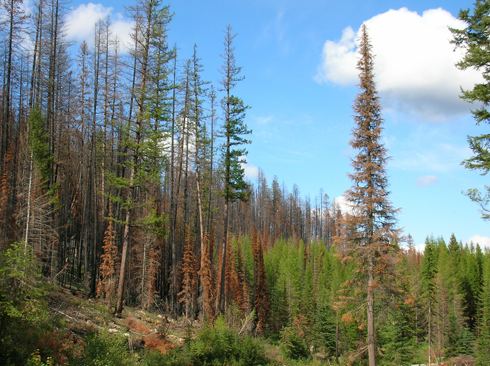
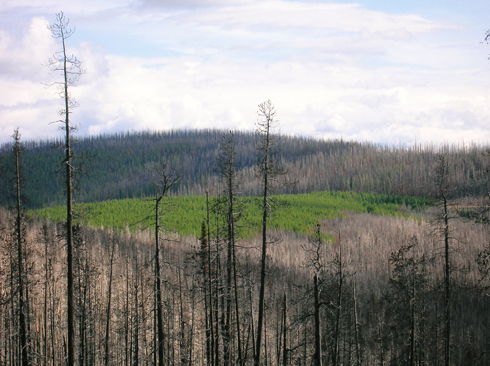
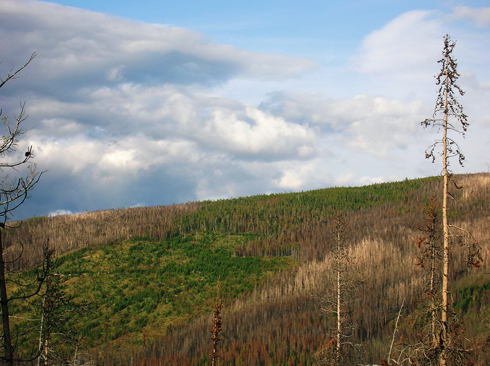
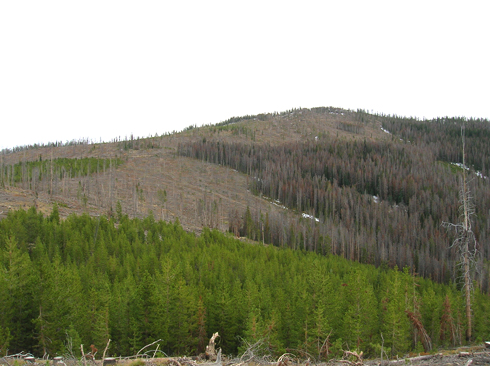
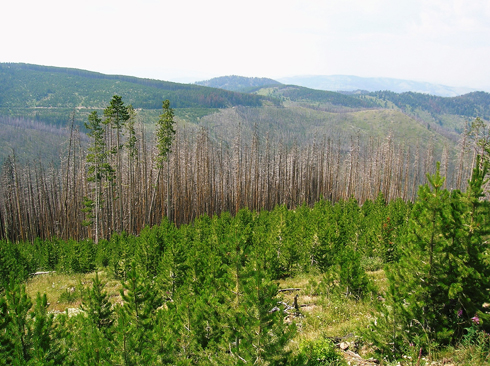
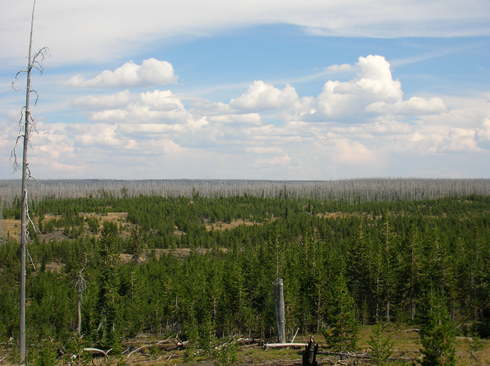
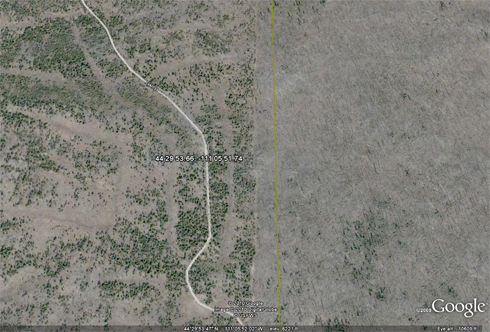
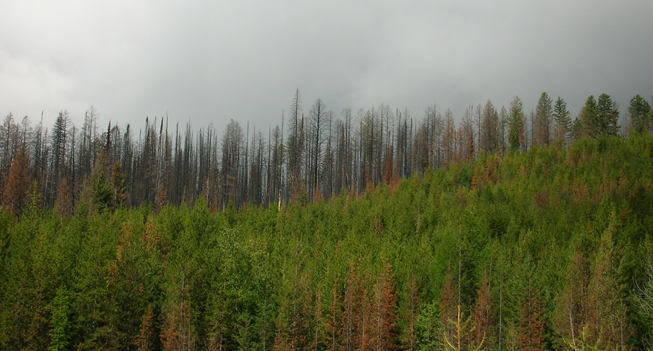

Excellent.
Weisensee’s photos prove that the Environmental Industry and their pseudo-science collaborators have been manufacturing information for decades in regards to the flammability of logged over lands.
In my career as a reforestation contractor, my crews and I planted or pre-commercially thinned about 80,000 acres of forestland. So far as I have been able to determine, none of these lands have ever burned in a wildfire. Zero. These types of management activities border wildfires — they do not provide fuel or continuity.
About six years ago I was involved in a project photographing the B&B wildfire results on the Santiam Pass:
http://www.ORWW.org/B&B_Complex/Repeat_Photography_Grid
The USFS abruptly cut off funding for this project before it was completed, apparently due to political pressure emanating from the Sisters District ecologist. The problem seems to have been documentation and distribution of information and photographs such as those contained in this article. No one wanted facts to confuse the issues.
Good job!